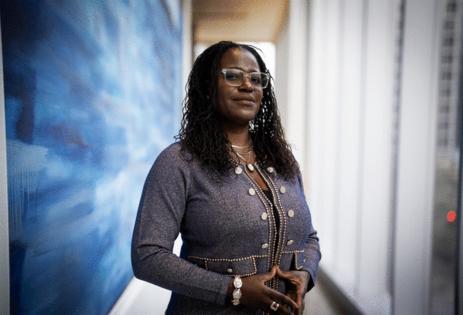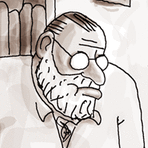Under new leadership, can Columbia College Chicago overcome its financial woes?
Published in News & Features
CHICAGO — Inside Columbia College Chicago’s glitzy glass student center, the walls are a canvas for campus life. “Call For Art,” lists a taped flyer. “Do you craft?” reads another. Beside them, hand-drawn stickers advertise a student podcast.
Over its 135-year history, the South Loop school has educated hundreds of thousands of alumni and artists — winners of Academy Awards, Grammys, Pulitzer Prizes. Elsewhere on campus, there’s a fashion lab, a bookbinding studio and a 260-seat movie theater.
That rich legacy of creatives was the main draw for Shantay Bolton, Columbia’s first new president in more than a decade. After the school’s nationwide, yearlong search, she officially stepped into the role on July 1.
“We are never losing sight of that mission,” Bolton told the Tribune in a recent interview. “We know that we are a part of the tapestry of this beautiful city.”
But Columbia is teetering on a financial precipice, a crisis the past president warned could pose an “existential threat.”
The school’s revenue streams have been hollowed out by shrinking enrollment, now hovering at 4,400 students. Administrators clawed their way back from a bitter, 49-day adjunct strike in late 2023. Still, even after program cuts and layoffs, they face a $40 million structural deficit.
It’s an uphill battle — yet Bolton remains undeterred.
The president has cast herself as a “student-centered” leader, a champion of the arts. She has professed a commitment to financial stability with equal parts pragmatism and optimism.
“I think we’ve been in crisis management mode too long,” Bolton said. “I believe we’re going to emerge on the other side of this.”
At the very least, her strategy is a morale boost. Once-disgruntled faculty members say there’s a renewed sense of hope on campus. Students, acutely aware of the stressors facing their institution, note that Bolton seems more present on campus.
Further cuts to academics or staffing are possible, if not likely — though what that looks like is still unclear. But after a decade of financial woes, many are eager to buy into Bolton’s vision as a means to rescue their beleaguered institution.
“For the first time in a long time, there’s a possibility of a future that we can look forward to,” said Diana Vallera, president of the Columbia Faculty Union.
Bolton’s newcomer status is part of her appeal. She arrived from the Georgia Institute of Technology, where she served as chief business officer. With a background in human resources, she has held senior roles at Washington University in St. Louis and Tulane University.
The St. Louis native is also the first woman of color to lead the school, and its first female president in nearly 90 years. (Columbia was founded by two women in 1890 as an oratory institute.)
The school’s diverse academic majors, from comedy writing to fashion design, helped it shed its commuter school reputation in the 1990s. Ask longtime faculty members, though, and they’ll note the urban campus is quieter than it used to be.
“(My floor) is like a ghost town,” said Deb Doetzer, an adjunct voice-over instructor. “Even when I go on other floors, I don’t see a lot of students hanging out.”
Two decades ago, Columbia enrolled roughly 12,000 students. This fall, only 4,461 undergraduates and graduates attended — a 62% drop from 2011.
Some of that is due to pressures outside of Columbia’s control: College enrollment nationwide has steadily fallen since 2010 amid plummeting birth rates. As prospective applicants reevaluate their return on investment, arts-focused institutions like Columbia are often left in the lurch.
Midsize and small colleges, heavily dependent on tuition dollars, are also more likely to feel the pinch of demographic shifts. In 2015, Columbia drew in $171 million from tuition. By last year, that total fell to $103 million.
“We were waiting for the demographic cliff to come, and all of the sudden, there we were, and it appeared that (administrators) weren’t making plans for it,” said Timothy McCain, an adjunct instructor in theater arts.
Spending soon outpaced revenue. While Columbia cashed out on three South Loop properties in 2017 and 2018, it unveiled a new $50 million student center just a year later. Administrators said it was financed through earlier real estate sales and private donations, but the college also issued $18 million in bonds to help cover construction costs.
Meanwhile, cuts crept into the classroom. Just weeks before the fall 2023 semester, department chairs were instructed to eliminate five to six courses from each academic program. That prompted the nearly 600 members of the faculty union to strike — which, after 49 days, became the longest work stoppage in higher education history.
“The old way of doing things was bullying and holding power over people,” said Vallera, the union president, who is also an adjunct instructor in photography.
A new contract was ratified after extensive negotiations in December that year. But the strike ultimately cost the college $13 million, sowing deep division between adjuncts, full-time faculty members and administrators. College President Kwang-Wu Kim resigned soon after, concluding a rocky 11-year tenure. The Tribune could not reach Kim for comment.
“It felt like there was always this ominous cloud of where you don’t know what’s going to get cut next,” said Brian Plocharczyk, an adjunct voice-over instructor.
Later that year, the college announced plans to discontinue 11 graduate and undergraduate programs, including the state’s only bachelor’s degree in American Sign Language interpretation. It has since laid off scores of faculty members. Tuition, currently at $34,088, has been raised the past three years, the Columbia Chronicle first reported.
“I feel like I didn’t get the education that I paid a lot of money for, and moved my whole life over here for,” said Gabby Aquino, 24, who graduated in late 2023 after studying ASL. Many of her professors were on strike and unable to attend class.
This summer, S&P downgraded Columbia’s debt rating to noninvestment grade, or “junk,” which makes future borrowing more expensive. The rating agency cited its slumping enrollment and depleted endowment. The college is still roughly $130 million in debt.
And with that, enter Bolton.
Despite the hurdles ahead of her, the president has championed a Columbia “renaissance.” She has launched a strategic planning process to outline the next three years, with four pillars: stabilizing enrollment, elevating the brand, strengthening philanthropy and improving operational efficiency.
Her predecessor once claimed he would recruit thousands of new students. Now, Bolton said, the goal is just to keep the enrollment steady. That includes building connections with Chicago Public Schools and other area school districts — roughly a quarter of the student body is from the city.
“I do not relitigate decisions of the past,” Bolton said. “(These goals) need to be realistic as we look at the landscape and the changing demographics of higher education.”
Reversing a long-standing enrollment decline will be difficult, according to David Attis, research director with education consultant firm EAB. He pointed to the negative feedback loop that comes with high student attrition. Plus, retention is as important as freshman recruitment — and Columbia’s four-year graduation rate is only 40%.
“That’s the best strategy, and everyone knows that, but not everyone has made progress on it,” Attis said. “It’s less expensive to retain a student than to bring in a new student.”
Still, Bolton is charging ahead. “We’re not just rebuilding Columbia. We are literally reimagining the possibilities,” she said.
She has other plans, too, including a new student scholarship fund, partnerships with civic and cultural organizations, revamped fundraising events and streamlined course offerings.
Among students and faculty, there’s a feeling of cautious optimism. For now, they’re just hoping it lasts.
“(Bolton) inherited a lot of missteps from the past that we’re having to come back from,” said Karla Fuller, a film professor and president of the Faculty Senate. “But I have no doubt that we can come back.”
The union president, Vallera, pointed to a recent breakthrough: After nearly two years, the union and administration settled outstanding contract issues in August. The agreement secured protections for senior adjuncts against enrollment changes.
The deal, overseen by Bolton, was outlined in an email co-signed by Vallera and interim Provost Suzanne McBride — a remarkable show of unity after years of deep-seated division.
“I know that for the first time in a long time, we feel that we not only have a seat at the table, but all the constituency groups are coming together,” Vallera said.
To be sure, Bolton said nothing is off the table to offset costs. At a student Q&A event in October, she conceded that it may be necessary to again increase tuition. But she stressed a commitment to affordability, particularly as a first-generation college graduate herself.
She told the Tribune that layoffs and academic programming cuts are a last resort. “While I cannot guarantee anything right at this moment … it is top of mind for me to try to reduce the impact to the greatest degree that I can,” Bolton said.
Fashion studies student Antonio Arce voiced concerns about tuition hikes at the event. Because his family offers no financial support, he’s worried about how he’ll afford day-to-day living expenses.
“That’s like a big stress on my everyday life,” Arce, 22, said. “Like, will I be able to go to school next semester? Will I be able to pay for this and graduate?”
But when he met Bolton after the event, he was struck by her affability. She was receptive to his questions. She shook his hand. “They’re saying it’s a big change to how it was a few years prior,” Arce said.
Student body President Jenna Davis, a senior fine arts major, meets with Bolton monthly as part of her leadership role. The 22-year-old is also worried about tuition, retention and enrollment, but said she feels a shift on campus.
“Being through all the previous presidents and the interim presidents, I would say that the energy on campus has been the most positive it’s ever been,” Davis said.
©2025 Chicago Tribune. Visit chicagotribune.com. Distributed by Tribune Content Agency, LLC.







Comments